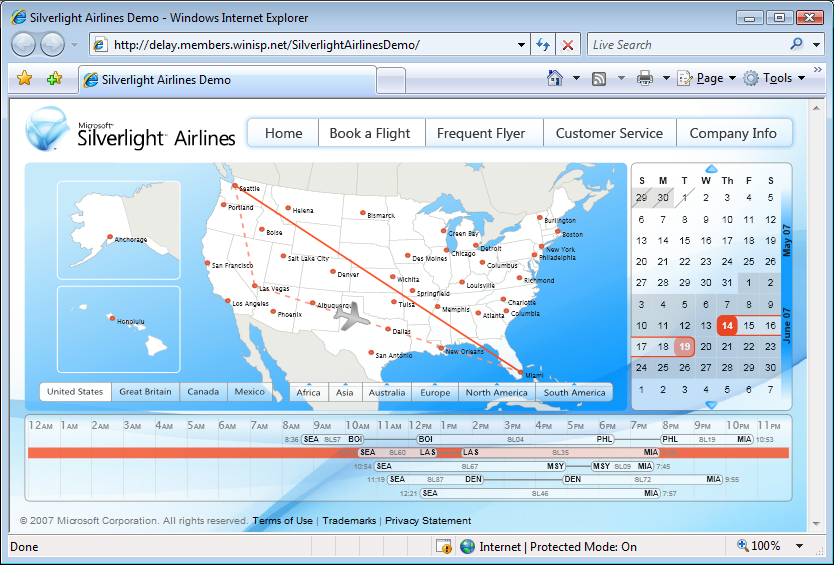The web just got even better... [Silverlight announced at MIX07!]
During his keynote at the MIX07 conference in Las Vegas, Scott Guthrie showed off some of the power of Microsoft's recently announced Silverlight platform. In particular, the ability to easily run managed code in the web browser - coupled with a powerful rendering engine - seems like it will to radically change the landscape of the web. My team had the privilege of writing the Silverlight Airlines demonstration he used to show off just how easy it is to develop with Silverlight. Demoed on stage, it looked something like the following image:

Now that your appetite is whetted, go ahead and click here (or on the image above) to view the demo in your browser with the Silverlight 1.1 Alpha thanks to the seamless cross-browser, cross-platform support that Silverlight provides.
When our manager Shawn Burke asked us to put this demo together, my coworker Ted Glaza and I had practically no experience with Silverlight or WPF. So we spent about a week playing around with the technology to learn how it worked. By that time, the general concept of the demo was fairly well established and we spent time the next week developing the foundations of the application. Before long, we had a working demo that we showed off to Scott. The third week was spent incorporating visual feedback from a designer and adding some finishing touches. For those of you keeping track at home, that's one cool app written by two developers in just three weeks - beginning with nothing and building on top of a platform that was still being developed - pretty compelling, I think!
In the spirit of openness and learning, you can click here to download the complete source code for this demo application and play around with it yourself!
A few notes on the application:
- It's implemented as three self-contained controls (the map, calendar, and itinerary picker) that are hooked together via a couple of simple event handlers and property accessors.
- The goal of code/design separation was achieved here to an extent I haven't experienced before. In particular, the fact that we were able to incorporate an external party's XAML design into our existing code with such ease was a rare treat.
- I experimented with a vaguely CSS-y approach to XAML design with the calendar and itinerary picker controls I wrote, overlapping a number of different styles and using opacity to display the right style at the right time. I liked the way it worked out here because it enabled me to (for example) completely define the look of the calendar's day cells in a single XAML file - even though that style is actually somewhat complex (there are different styles for alternating months, weekends, hovering, selection, etc.).
- The "plane flying" animation was Ted's doing and adds a really nice effect. All it took to implement was a plane graphic, a few transforms, a couple of animations, and a bit of high school math. :)
- The XAML content is automatically resized to fit the browser window (while maintaining its original aspect ratio) with some JavaScript code that hooks the Silverlight control's onLoad and onResize events and manipulates two simple transforms it creates for that purpose. Silverlight lets you program against it with C# and JavaScript - at the same time!
- In order to compile and build the source code, you need Visual Studio "Orcas" Beta 1 and the Silverlight Tools installed on you machine. Complete details and download links for these tools (and others) can be found on the Silverlight web site.
- The inspiration for the demo application came from Bret Victor's Magic Ink essay which is a great read and recommended for anyone who's interested in user interface design.
The Silverlight Airlines demo was a fun project to work on - I look forward to be seeing (and doing!) a lot more with Silverlight in the coming days!
PS - Since the keynote presentation, there has been some interest in reusing the calendar control. Beyond making the source code available here, I may write a follow-up blog post going into more detail about the calendar itself. As a quick teaser: it's capable of more sophisticated display than what's in the demo application. :)
PPS - If you watched the Scott Guthrie keynote, you probably saw that there was a time Scott tried to switch the display screen over to the Mac to demonstrate something and it took a while for the conference's A/V folks to actually make the switch. A couple of people have asked if this delay was due to a problem with the Mac or Silverlight. I happen to have been sitting backstage mere inches away from the Mac in question (conferences use KVM switches to keep all the demo machines backstage) and I can assure you that there was no technical issue with the Mac or Silverlight. Aside from the conference tech taking a little while to switch the display over, there were no technical glitches during the demo. :)